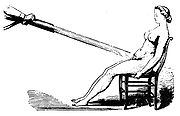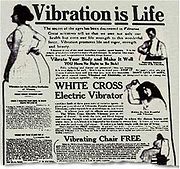
Female hysteria
Encyclopedia

Medical diagnosis
Medical diagnosis refers both to the process of attempting to determine or identify a possible disease or disorder , and to the opinion reached by this process...
, made exclusively in women, which is today no longer recognized by modern medical authorities as a medical disorder. Its diagnosis and treatment were routine for many hundreds of years in Western Europe. Hysteria was widely discussed in the medical literature of the 19th century. Women considered to be suffering from it exhibited a wide array of symptoms including faintness, nervousness, insomnia, fluid retention, heaviness in abdomen, muscle spasm, shortness of breath, irritability, loss of appetite for food or sex, and "a tendency to cause trouble".
Since ancient times women considered to be suffering from hysteria
Hysteria
Hysteria, in its colloquial use, describes unmanageable emotional excesses. People who are "hysterical" often lose self-control due to an overwhelming fear that may be caused by multiple events in one's past that involved some sort of severe conflict; the fear can be centered on a body part, or,...
would sometimes undergo "pelvic massage" — manual stimulation of the genitals
Masturbation
Masturbation refers to sexual stimulation of a person's own genitals, usually to the point of orgasm. The stimulation can be performed manually, by use of objects or tools, or by some combination of these methods. Masturbation is a common form of autoeroticism...
by the doctor until the patient experienced "hysterical paroxysm" (orgasm
Orgasm
Orgasm is the peak of the plateau phase of the sexual response cycle, characterized by an intense sensation of pleasure...
).
Early history
The history of the notion of hysteria can be traced to ancient times; in ancient Greece it was described in the gynecological treatises of the Hippocratic corpusHippocratic Corpus
The Hippocratic Corpus , or Hippocratic Collection, is a collection of around 60 early Ancient Greek medical works strongly associated with the physician Hippocrates and his teachings...
, which date from the 5th and 4th centuries BC. Plato
Plato
Plato , was a Classical Greek philosopher, mathematician, student of Socrates, writer of philosophical dialogues, and founder of the Academy in Athens, the first institution of higher learning in the Western world. Along with his mentor, Socrates, and his student, Aristotle, Plato helped to lay the...
's dialogue Timaeus
Timaeus (dialogue)
Timaeus is one of Plato's dialogues, mostly in the form of a long monologue given by the title character, written circa 360 BC. The work puts forward speculation on the nature of the physical world and human beings. It is followed by the dialogue Critias.Speakers of the dialogue are Socrates,...
compares a woman's uterus
Uterus
The uterus or womb is a major female hormone-responsive reproductive sex organ of most mammals including humans. One end, the cervix, opens into the vagina, while the other is connected to one or both fallopian tubes, depending on the species...
to a living creature that wanders throughout a woman’s body, "blocking passages, obstructing breathing, and causing disease." The concept of a pathological, wandering womb was later viewed as the source of the term hysteria, which stems from the Greek cognate of uterus, ὑστέρα (hystera).
Galen
Galen
Aelius Galenus or Claudius Galenus , better known as Galen of Pergamon , was a prominent Roman physician, surgeon and philosopher...
, a prominent physician from the 2nd century, wrote that hysteria was a disease caused by sexual deprivation in particularly passionate women: hysteria was noted quite often in virgins, nuns, widows and, occasionally, married women. The prescription in medieval and renaissance medicine was intercourse if married, marriage if single, or vaginal massage (pelvic massage) by a midwife as a last recourse.
Nineteenth century

Rachel P. Maines has observed that such cases were quite profitable for physicians, since the patients were at no risk of death, but needed constant treatment. The only problem was that physicians did not enjoy the tedious task of vaginal massage (generally referred to as 'pelvic massage'): The technique was difficult for a physician to master and could take hours to achieve "hysterical paroxysm." Referral to midwives, which had been common practice, meant a loss of business for the physician. The Chaise Longue and Fainting couch
Fainting couch
A fainting couch is a couch with a back that is traditionally raised at one end. The back may be situated completely at one side of the couch, or may wrap around and extend the entire length of the piece much like a traditional couch...
became popular home furniture to make women more comfortable during home treatment. Fainting room
Fainting room
A fainting room was a room, used during the Victorian era, where women could go to rest when feeling faint. Fainting rooms often included fainting couches where women would faint or recline without fearing bodily harm...
s were also used for more privacy during home treatment.
A solution was the invention of massage devices, which shortened treatment from hours to minutes, removing the need for midwives and increasing a physician’s treatment capacity. Already at the beginning of the 19th century, hydrotherapy
Hydrotherapy
Hydrotherapy, formerly called hydropathy, involves the use of water for pain-relief and treating illness. The term hydrotherapy itself is synonymous with the term water cure as it was originally marketed by practitioners and promoters in the 19th century...
devices were available at Bath, and by the mid-19th century, they were popular at many high-profile bathing resorts across Europe and in America. By 1870, a clockwork-driven vibrator was available for physicians. In 1873, the first electromechanical vibrator was used at an asylum in France for the treatment of hysteria.
While physicians of the period acknowledged that the disorder stemmed from sexual dissatisfaction, they seemed unaware of or unwilling to admit the sexual purposes of the devices used to treat it. In fact, the introduction of the speculum
Speculum (medical)
A speculum is a medical tool for investigating body cavities, with a form dependent on the body cavity for which it is designed. In old texts, the speculum may also be referred to as a diopter or dioptra...
was far more controversial than that of the vibrator.
By the 20th century, the spread of home electricity brought the vibrator to the consumer market. The appeal of cheaper treatment in the privacy of one’s own home understandably made the vibrator a popular early home appliance. In fact, the electric home vibrator was on the market before many other home appliance ’essentials’: nine years before the electric vacuum cleaner and 10 years before the electric iron. A page from a Sears catalog
Sears, Roebuck and Company
Sears, officially named Sears, Roebuck and Co., is an American chain of department stores which was founded by Richard Warren Sears and Alvah Curtis Roebuck in the late 19th century...
of home electrical appliances from 1918 includes a portable vibrator with attachments, billed as ”Very useful and satisfactory for home service.”
Other cures for female hysteria included bed rest, bland food, seclusion, refraining from mentally taxing tasks (for example, reading) and sensory deprivation.
Decline

Conversion disorder
Conversion disorder is a condition in which patients present with neurological symptoms such as numbness, blindness, paralysis, or fits without a neurological cause. It is thought that these problems arise in response to difficulties in the patient's life, and conversion is considered a psychiatric...
s such as hysteria, and it therefore no longer gets the desired response from society.
With so many possible symptoms, hysteria was always considered a catchall diagnosis
Wastebasket diagnosis
A trashcan diagnosis or wastebasket diagnosis is a vague or fake medical or psychiatric diagnosis given to a patient or to medical records department for essentially non-medical reasons...
where any unidentifiable ailment could be assigned. As diagnostic techniques improved, the number of cases were pared down until nothing was left. For instance, before the introduction of electroencephalography
Electroencephalography
Electroencephalography is the recording of electrical activity along the scalp. EEG measures voltage fluctuations resulting from ionic current flows within the neurons of the brain...
, epilepsy
Epilepsy
Epilepsy is a common chronic neurological disorder characterized by seizures. These seizures are transient signs and/or symptoms of abnormal, excessive or hypersynchronous neuronal activity in the brain.About 50 million people worldwide have epilepsy, and nearly two out of every three new cases...
was frequently confused with hysteria. Many cases that had previously been labeled hysteria, were reclassified by Sigmund Freud
Sigmund Freud
Sigmund Freud , born Sigismund Schlomo Freud , was an Austrian neurologist who founded the discipline of psychoanalysis...
as anxiety neuroses.
Today, female hysteria is no longer a recognized illness, but different manifestations of hysteria are recognized in other conditions such as schizophrenia
Schizophrenia
Schizophrenia is a mental disorder characterized by a disintegration of thought processes and of emotional responsiveness. It most commonly manifests itself as auditory hallucinations, paranoid or bizarre delusions, or disorganized speech and thinking, and it is accompanied by significant social...
, conversion disorder, and anxiety attacks.
External links
- Erika Kinetz, "Is Hysteria Real? Brain Images Say Yes", New York Times, Sept 2006.

